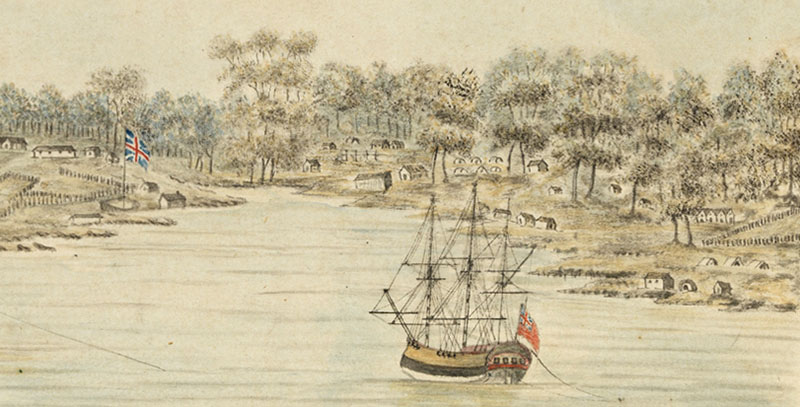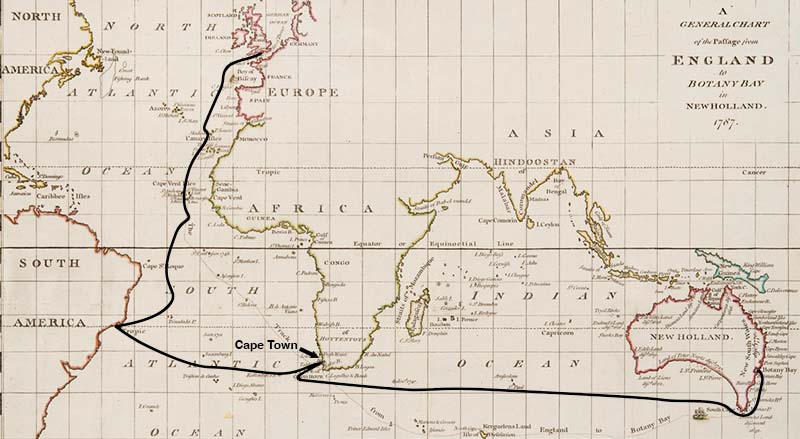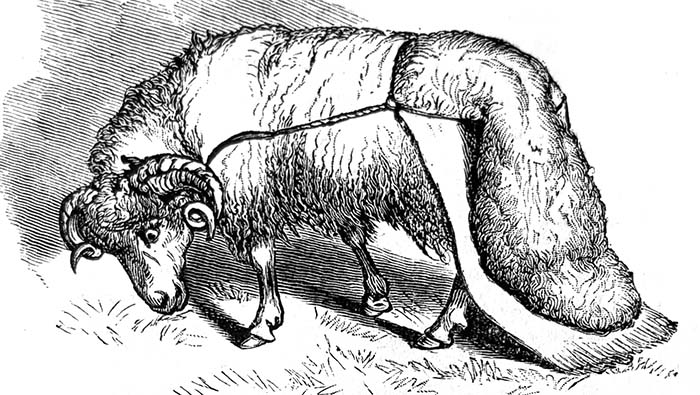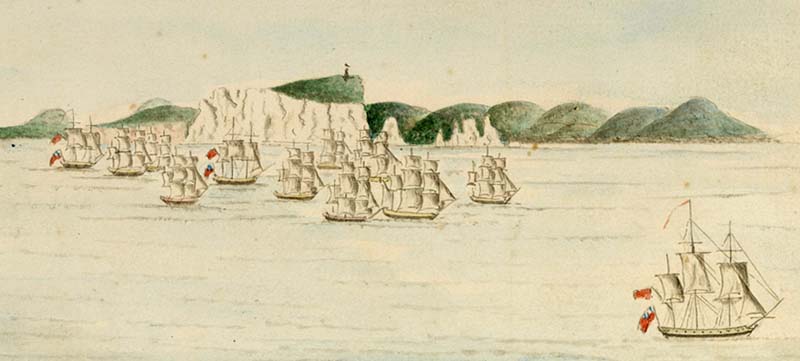
The Millstones on the First Fleet:
Australia's First Full-sized Millstones
Including Cape Town, Cape of Good Hope, Scarborough
Singleton Mills homepage > Millstones overview > Millstones on the First Fleet
A vital cargo on the First Fleet
In 1788, when the First Fleet sailed into Sydney Harbour in New South Wales (NSW), one ship was carrying a cargo which was particularly vital for the future of the colony. The convict transport Scarborough had, deep in its hold, four large millstones for grinding flour. The new penal colony would need these millstones to grind flour for its 1400 people.

Above, one of the ships of the First Fleet moored at Sydney Cove in 1788. Detail from a painting by William Bradley. State Library of NSW.
On 22 February 1788, these four millstones were unloaded from the Scarborough at Sydney Cove.[1] The colony had no wharf at this stage, and each millstone would have weighed about a tonne. So, moving these stones from the Scarborough to the shore would have been a challenging task.
Aboriginal people had used small, rounded stones to grind native grasses for thousands of years in this country. However, the four millstones on the First Fleet were Australia's first full-sized industrial millstones – designed to operate in a mechanised flour mill.
The four millstones from the First Fleet would lay the foundation of a flour milling industry for the future nation of Australia.
Where did these four millstones come from?
Unfortunately, the surviving records that we have found so far do not provide a clear answer. However, there are two main possibilities:
Option 1. They were purchased in Cape Town in 1787, during the First Fleet's journey to Australia;
or
Option 2. They were part of the provisions for the new penal colony that were loaded onto the First Fleet ships before they left England in 1787.

Above, the route taken in 1787–1788 by the First Fleet, from England, via Rio de Janeiro in South America, and Cape Town in Southern Africa, to Sydney Cove in Australia (then called 'New Holland'). Map modified from 'A General Chart of the Passage from England to Botany Bay in New Holland, by John Andrews. State Library of NSW.
Let us explore the evidence for each of these options.
Option 1. The millstones were purchased in Cape Town.
Some modern reviews of Australian milling history[2, 3] say that the First Fleet's four millstones were purchased in 1787 at Cape Town, a Dutch trading port at the southern tip of Africa (see map above).
An excellent Dictionary of Sydney article by Sybil Jack, states, 'Phillip brought four millstones and grain from the Cape…' [4] The source cited for this information was Keith Farrer's book, 'To feed a Nation'.
However, the actual wording in Farrer's book is:
'At the Cape, Phillip obtained grain, but although four millstones were landed at Sydney Cove from the Scarborough on 22 February 1788, there was neither a millwright nor a suitable and reliable millstream…' [5]
Note that Farrer does not actually state here, that the four millstones were obtained at Cape Town.
About Cape Town
In 1787, Cape Town was a Dutch trading port in Africa on a major seafaring trading route from Europe to Asia. The First Fleet stopped at Cape Town to buy provisions, before sailing on to Australia. Cape Town was regarded as the final civilised place that the First Fleet would visit, before they arrived in Australia.

Above, the eleven ships of the First Fleet moored at Cape Town on the southern tip of Africa in November 1787. Table Mountain is the flat topped mountain seen behind the town. Detail from a painting by William Bradley. State Library of NSW.
John White, principal surgeon on the First Fleet, climbed Table Mountain behind Cape Town during his stay there, and described the view of Cape Town from there as follows:
'The regularity of the streets of the town, which intersect each other at right angles; the buildings, gardens, castle, and forts, with twenty-three ships then at anchor in the bay, all which appeared directly underneath us, was a sight beautiful and pleasing beyond description.' [6]
High price of provisions at Cape Town during the First Fleet visit
In 1787, the prices of charged for provisions at Cape Town were very high. Arthur Bowes Smyth, surgeon on the First Fleet vessel, Lady Penrhyn, wrote in his journal:
'Every article while the fleet lay here was advanced to treble its usual price…' [7]
Captain Arthur Phillip also wrote in his journal:
'This supply, considering that the country had previously suffered from a dearth, was very considerable; but it was purchased of course at a higher expence considerably than it would have been in a time of greater plenty.' [8]
Large quantities of provisions purchased at Cape Town
Nevertheless, Phillip needed to buy a large amount of fresh food and livestock that were crucial for the new settlement.
So, during their one month stay at Cape Town in 1787, the ships of the First Fleet were loaded with huge supplies of wheat, bread, meat, fruit, and vegetables, as well as water. In addition, more than 500 animals were purchased at Cape Town and loaded onto the ships: cattle, sheep, pigs, goats, horses, and various kinds of poultry. Phillip described the result as follows:
'In the course of a month, the live stock and other provisions were procured; and the ships, having on board not less than five hundred animals of different kinds, but chiefly poultry, put on an appearance which naturally enough excited the idea of Noah's ark.' [9]

Above, at least 29 sheep were included in the livestock purchased for the First Fleet at Cape Town in 1787. These were Cape Fat-Tailed Sheep – a local breed with an an enormous tail and an astonishing story! Image from an 1881 article on Fat-Tailed Sheep. [10]
South African herdsmen made little trolleys for their Fat-Tailed Sheep to pull, so that their tails did not drag on the ground! Read the full story of the Fat-Tailed Sheep |
Major efforts were made to pack as many provisions as possible onto the ships at Cape Town. For instance, William Bradley, a British Naval Officer who sailed to Australia on the First Fleet vessel, Sirius, described some of the work as follows:
'Eight of the Main deck Guns were struck down in the Hold & the deck clear'd for the reception of Cattle, for which purpose stalls, &c. were built fore & aft the deck just leaving room to work the Cables...
The women Convicts on b.d [board] the Friendship were removed on board the Charlotte, P.re of Wales & Lady Penryhne & those cabins which they occupied were fitted for sheep' [11]
Were the four large millstones purchased too, at great expense, at Cape Town, and added to the heavily laden First Fleet ships?
Or were inexpensive millstones supplied in England, and stowed as ballast right from the start of the voyage?
Option 2. The millstones were provisions loaded onto the First Fleet in England.
Millstones were in the list of provisions sent to Botany Bay (Sydney)
It was clearly seen, well before the First Fleet departed from England, that the new colony would need equipment for large scale flour mills.

Above, the eleven ships of the First Fleet sail away from England on 13 May 1787. Detail from a painting by William Bradley. State Library of NSW.
A list of 'Articles sent by the First Fleet to Botany Bay' was compiled from the account books of the Admiralty in 1787. This was later reproduced in the Historical Records of NSW.
This list included equipment needed for a full-scale flour mill:
'... 2 millstones, spindles,A &c.' [12]
A. Spindle. This is the rotating drive shaft that transmits power from a waterwheel or windmill blade to the upper millstone (or Runner Stone) of a full-scale flour mill, during the milling process.
Inexpensive millstones were plentiful in England
In 1787, millstones would have been readily available in England:
– Inexpensive millstones were quarried locally from Millstone Grit, Old Red Sandstone, and granite stone in Britain; and
– Numerous French Burr Stones were also assembled in Britain for use in local flour mills, because they produced a highly-desirable, fine, white flour. However, French Burr Stones were very expensive.
The First Fleet's millstones were provided to grind flour for a convict settlement, so the cheaper stones, such as Millstone Grits, might have been seen as a good choice by the British authorities. As the new colonists would later discover to their regret, Britain supplied a considerable amount of low-quality equipment to the new colony, as a cost-saving measure.[13]
Millstones as ship's ballast
Millstones also made good ballast for a sailing ship. They are heavy, flat, and compact, and could be stowed deep in a ship's hold, to stabilise the ship throughout a long ocean voyage.
The First Fleet Ship Logs
Fascinating extracts of the Ship's Logs from the Scarborough, and five other First Fleet ships, are transcribed in the Historical Records of NSW, Volume 2.
For each ship, daily events have been recorded, starting from the time when the ships were loaded in England, through the long ocean voyage, and ending when the ships were unloaded in Sydney Cove.
Unfortunately, the ship's log extracts for the Scarborough provide little detail about the loading of provisions in England in February and March 1787:
'Received from the Lady Penrhyn sundry stores for Botany Bay … Came on board 185 convicts … At 2pm the Commodore made a signal for weighing [anchor]…' [14]
However, they do provide more detail about the loading of provisions in Cape Town in October and November 1787:
'Moored in Table bay … Received on board, fresh beet, greens, and soft bread. …Received on board, 12 piggs and 12 bushells of corn for Major Ross. …The Commodore made the signal to get under weigh….' [15]
No mention was made of loading millstones onto the Scarborough in these extracts of the ship's logs, in England nor in Cape Town.
This research continues! Can you provide more information? Please Contact Us.
Our conclusion
The records that we have seen so far do not provide a clear answer about where the First Fleet millstones came from.
However, our research so far favours the second option – that Australia's first four millstones were part of the provisions loaded onto the First Fleet in England:
– The costs of goods purchased at Cape Town in 1787 were extremely high; and
– The new supplies, alone, of food, water, and livestock purchased at Cape Town filled the First Fleet ships to capacity.
In contrast,
– Millstones were on a list of articles that were sent to Sydney on the First Fleet, as a provision for the colony;
– Inexpensive millstones such as Millstone Grit stones were readily available in England; and
– Millstones would have provided excellent ballast for the long journey to Australia.
What happened to the First Fleet Millstones after they arrived in Sydney?
In 1788, efforts to use Australia's first four full-sized millstones in Sydney soon ran into serious problems, as nobody on the First Fleet had sufficient skills to build or operate a mechanised flour mill.
Read the fascinating story of how Sydney's first mill builders strived to build flour mills for the new colony. Through arduous trial and error, they at length succeeded in building successful mills, against massive odds.

Above, the construction of these early windmills of Sydney was only achieved after years of immense difficulties. Source: 'West view of Sydney, New South Wales', ca. 1810 by Walter Akhurst and Co. State Library of NSW.
Australia went on to build an extensive, successful flour milling industry, with hundreds of mills established in cities and small towns across the continent. However, it is fascinating to reflect on those first four millstones, brought by the First Fleet to Sydney, that laid the foundation for flour milling in this country.
REFERENCES.
HRA – Historical Records of Australia. https://nla.gov.au/nla.obj-442186184
HRNSW – Historical Records of New South Wales. https://nla.gov.au/nla.obj-343230396
1. HRNSW, Vol 2, page 403 (image 439).
2. Jack, Sybil (2017) Sydney flour mills before 1850. The Dictionary of Sydney website. Retrieved 8 May 2025.
3. Ashton, P, Jennings, J and McCorquodale, J (2022) The power of flour. The Australian Milling Museum, Bathurst, NSW.
4. Jack, Sybil (2017) Sydney flour mills before 1850. The Dictionary of Sydney website. Retrieved 8 May 2025.
5. Farrer, KTH (2005) To feed a nation : a history of Australian food science and technology. Chapter 3. CSIRO Pub., Collingwood, Victoria.
6. White, John (1790) Journal of a Voyage to New South Wales. Project Gutenberg Australia.
7. Smyth, Arthur Bowes (1787–1789) A Journal of a Voyage from Portsmouth to New South Wales and China. Edited by Colin Choat, 2020. Project Gutenberg Australia.
8. Phillip, Arthur (1789) The Voyage of Governor Phillip to Botany Bay. John Stockdale, London. Project Gutenberg.
9. Ibid.
10. Locher, Arthur (1881) The Fat-Tailed, or Broad-Tailed, Sheep. Frank Leslie's Popular Monthly, Vol 11(5), 567-570. Accessed via Internet Archive, May 2025.
11. Bradley, William (1802) A Voyage to New South Wales, December 1786 - May 1792. Project Gutenberg Australia.
12. HRNSW, Vol 2, page 388 (image 424). This 1787 list was one of set of documents from 'Phillip, 1783–1792', later added to HRNSW, Volume 2, as Appendix A.
13. For example: HRA, 19 March 1792, Series 1, Vol 1, page 339. Governor Phillip wrote, 'The iron mills which have been sent out are very soon rendered useless; they are said to be not of the best kind,…'
14. HRNSW, Vol 2, page 402 (image 438).
15. Ibid.
Read More About Millstones
•• Overview •• French Burr Stones •• Basalt-like Cullin Stones •• Millstone Grit •• Old Red Sandstone, Puddingstone, and Lodswoth Stone •• Granite •• Limestone •• Artificial Millstones •• Colonial Millstones •• Norfolk Island Millstones